Web
and Book design, Copyright, Kellscraft Studio 1999-2008 (Return to Web Text-ures) |  (HOME) |
| MAINE FROM
KITTERY
TO PORTLAND KITTERY shares
with
Portsmouth in forming a natural port unit. Its ancient navy yard and
its old
dwellings ally it with our prerevolutionary history. The drive to
Gerrish
Island is worth while. York is a large
town, with ancient traditions, with its jail museum, and with beach,
harbor,
nooks, and cliffs, and a river, so that in miniature it contains
practically
every feature of Maine coast scenery. Its accessibility has made all
these features
largely available, and it may be thought of as the township in Maine
epitomizing, more than any other, the state's shore attractions. For we
must
not forget that Mt. Desert contains several townships. The communities
of
Ogunquit and Kennebunkport enjoy the same varieties of coast line, in
and out,
and up and down, as characterize York. All these communities are
supplied with
every sort of marine beauty. As the point where the sea and shore meet
is said
to be the initial point of life on our planet, it would almost seem as
if, by a
kind of atavism, we hark back to the beaches and the bluffs of the
ocean as to
the places where we are most at home, and therefore most content. Wells has its
long
littoral of quiet outlines. Beaches of the Maine coast are sometimes
like those
in Florida, being in the form of elongated dunes behind which lagoons
lie, most
picturesque in their contours. This is true of Ogunquit, Wells, and
Crescent
Surf, a portion of Kennebunkport. A series of islands off Kennebunkport
affords
a retreat. The naming of
islands is a reflection of many human moods, some of them humorous. The
Maine
islands have the usual names repeated after those of other regions.
Nearly all
the domestic animals and various wild beasts are represented. Somewhere
in
Maine or on the New England coast we have Sow and Pigs, Ram, Cow, Goat,
and
doubtless we might go on with Upper Goose, Goslings, etc. There ought
to be a
commission appointed on geographical names. Of course its suggestions
never
would be followed, but we would enjoy possessing one more
commission—the
substitute for a conscience. At least, however, we might dignify our
landscapes
by re-naming localities suffering from duplication of names. At Biddeford
and
Saco we find the river of which Whittier wrote, the Saco. The stream
has
finished its leaps and lazy meanderings and is here brought down to
hard work
grinding in the prison house of its dams. At times, however, to assert
itself,
the water comes down with overwhelming flood, and dashes over the
natural crags
in beautiful confusion. If we could confine our view to the splendid
cascades
made here by the Saco we should be well content. Biddeford Pool is a
pleasing
detour. Old Orchard
Beach
cannot be spoiled even by the unsightliness of its "culture"
features. Its tremendous reach in the form of a flattened crescent, its
great
breadth of sands, its limpid, dimpled surface of a summer's day, and
its
roaring regiments of breakers in the stormy season, give it always an
interest
that does not wane. It is the great beach of Maine. Scarboro also
enjoys a long
beach somewhat more removed from the greater crowds of Old Orchard. And
so we
come to Cape Elizabeth forming the southern side of Casco Bay. The
endless line
of rock coasts, with here and there a fine bluff, provide a refuge for
those
who would be silent and alone. There are combinations of cove and cliff
of
distinguished beauty. The close proximity of Cape Elizabeth to Portland
allows
its development in a more complete manner than could otherwise be the
case. It
is enjoyed for many months of the year. Its famous Portland Head light
marks
the channel between the Cape and Cushing Island, and is one of the best
known
points on the Atlantic coast. Casco Bay,
buttressed as it is against the open sea, by islands so overlapping as
to make
Portland Harbor remarkable for its safety and availability in all
weathers, is
a body of water worth all the time one can give to it. Portland seen
from
the roofs of its lofty buildings, displays a harbor almost environing
the city.
Its harbor has been sung by poets and praised by promoters. Nothing too
good of
it can be said. Our interest, however, is in its remarkable beauty.
Portland is
the logical point for seeing the best of the east. It is a moderate
run,
passing by lake, hill, and stream to the White Mountains. It is
convenient to
Boston, Bar Harbor, and the interior of the state. Its people have
adequately
met the needs of travelers. The city itself is dignified and beautiful
so far
as any city at this date in America can be. Its public institutions are
of such
a character as to engross one during the rainy days. The river park and
the
near-by suburbs, as ancient Falmouth, and the mosquito fleet for runs
in every
direction to the large and small islands of its bay, supply the call of
an
active American. Whatever his quest for summer life, he should find it
in or
near Portland. The slopes of
Falmouth to the sea are of striking beauty. The sea is here, to be
sure, but we
are still in Casco Bay so that one enjoys the quiet of waters incident
to the
islands seen some miles out. Every one of
the
islands ought to be the seat of a summer home. All this will come in
time. The
sense of owning a little kingdom, with natural barriers all about it,
answers
an innate human trait. We can understand the spirit of a man who would
rather
be king in an island, though he have no subject other than himself and
the cat,
than to be one in a crowd. The possession of a modern motor-boat
entirely
changes the situation as regards the ownership of an island. Formerly
one was
dependent on the moods of the winds or a stuffy steamer. The motor-boat
is a
close second to its land cousin, the automobile. Can anything be more
fascinating
than the opportunity of skimming about in a boat among the islands of
Maine
during the day, and returning to one's own little kingdom at night? The sea needs
no
repairs and is never out of commission. During the storms of winter the
family
may occupy itself in the library, the laboratory, the shop, or the
barn. It has
been found that periods of vigorous activity, interspersed with periods
of
repose, carry people onward to success. It is necessary to digest the
material
acquired by travel and observation. How much we should be enriched if
some of
the brilliant globe trotters of past centuries had made an occasional
minute of
their goings and comings! One or two vague or incredible tales are
about all
that we have to tell us how very early settlers lived in America. It
was only
after many years that Bradford wrote his simple narrative about
Plymouth. Even
so, that was lost to the light for centuries. History touching life has
been
written only at long intervals and at distant spaces. We wander along
the
coast of Maine where the earliest houses stood and wonder what their
dwellers
thought and did. The things which history records are the least
interesting. If
we could follow a seventeenth-century settler through a season's
activities
from day to day, it would be far more interesting than any records they
have
actually left us. If we could know what the early fathers ate, and how
they
cooked it, according to their own story, and could be told in some
homely
record of their conversations and avocations, the past and the present
could be
linked much more closely. It is the tendency in life and history to
overemphasize salient features, according to the famous saying, that
the nation
is blessed which has no history. We are not, however, of that opinion.
That rare
combination of activity which makes history, and the occasional repose
which
regards it in perspective can scarcely be found among the early
American
settlers. Regarding the dwellings which are erected by summer residents along the coast of Maine, perhaps the less said, the better. In most instances they will fall in the winds. The proper material for a Maine coast house is of course the stones that abound everywhere. We do not mean the round boulders such as are in stone walls, which stones were never seen in dwellings in the olden day, and never should be seen in our own. The craze for cobble-stone chimneys, gates, and dwellings is based on lack of thought, lack of taste, and lack of knowledge. The ledges in Maine are in many places broken so as to provide angular stones fit for building. We hope that one hundred years from now the Maine coast may show many thousands of structures resting upon the primal rock, and rising from fragments of the same material. Thus their solidity will satisfy the heart of man, their age will give continuity to the families that dwell in them, and their artistic lines will melt into their surroundings. 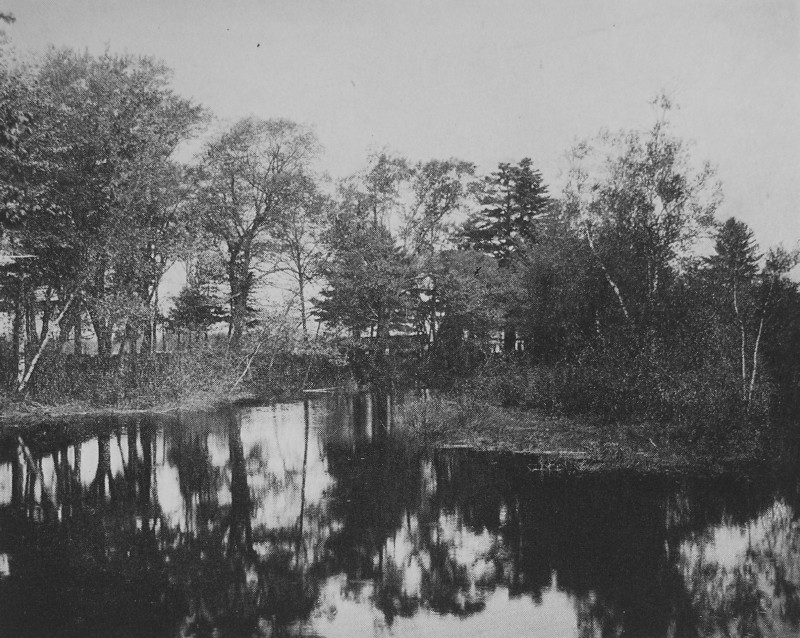 OLD RIVER - FRYEBURG 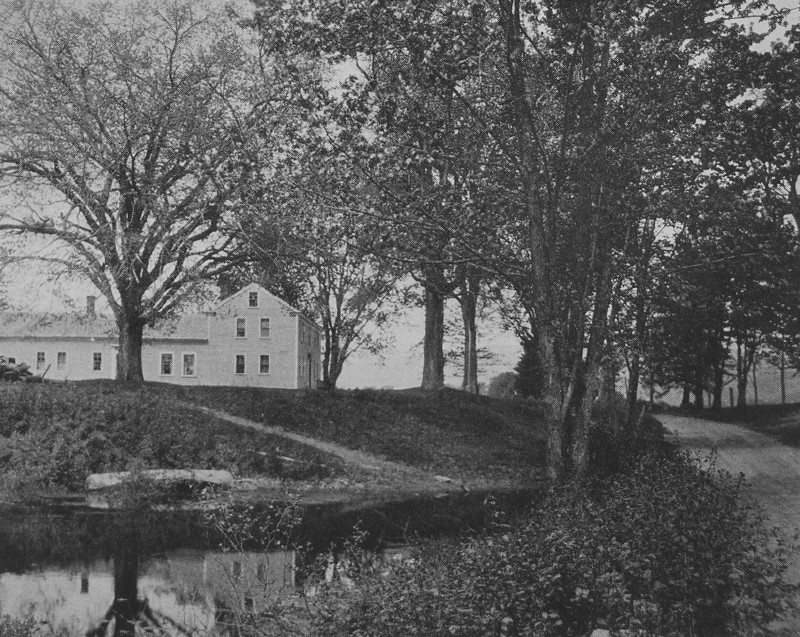 RIVER KNOLL FARM 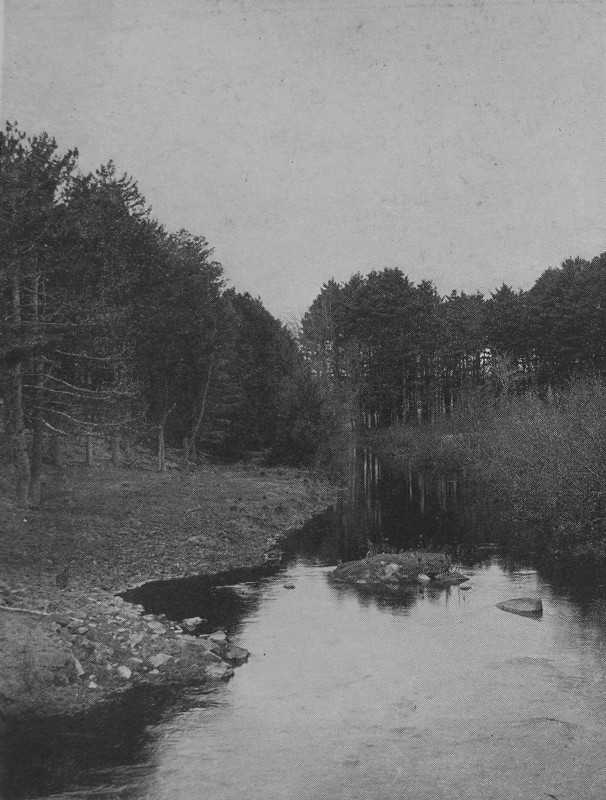 YORK EVERGREENS 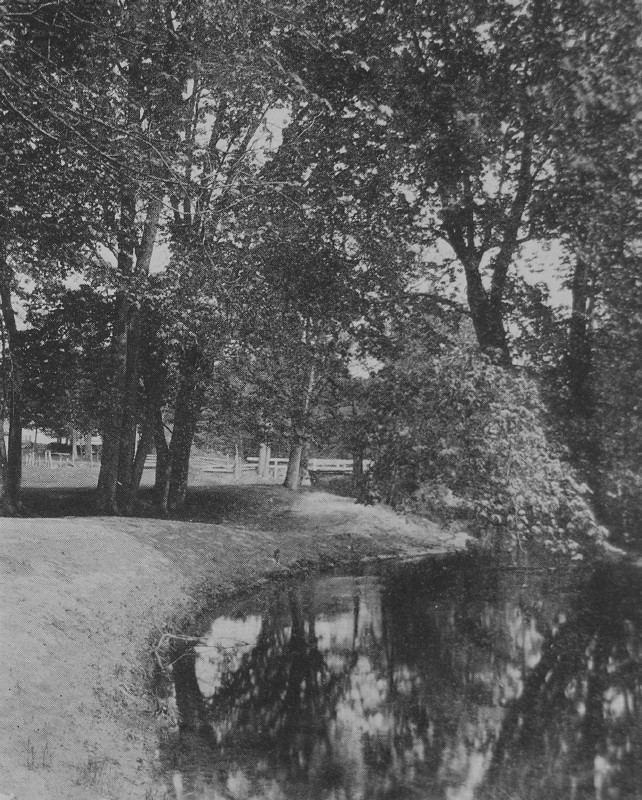 SHADOWS ON SAND - FRYEBURG 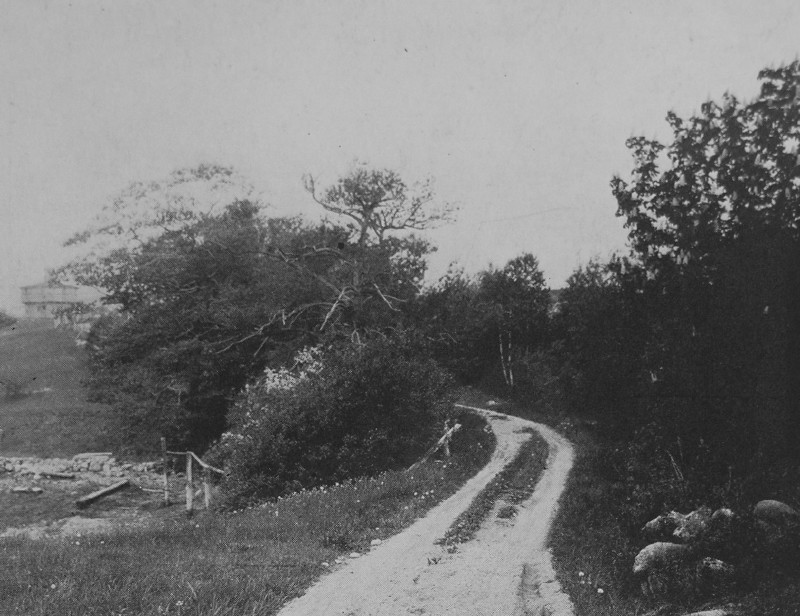 THE ROAD TO THE FORT - NORTH EDGECOMB 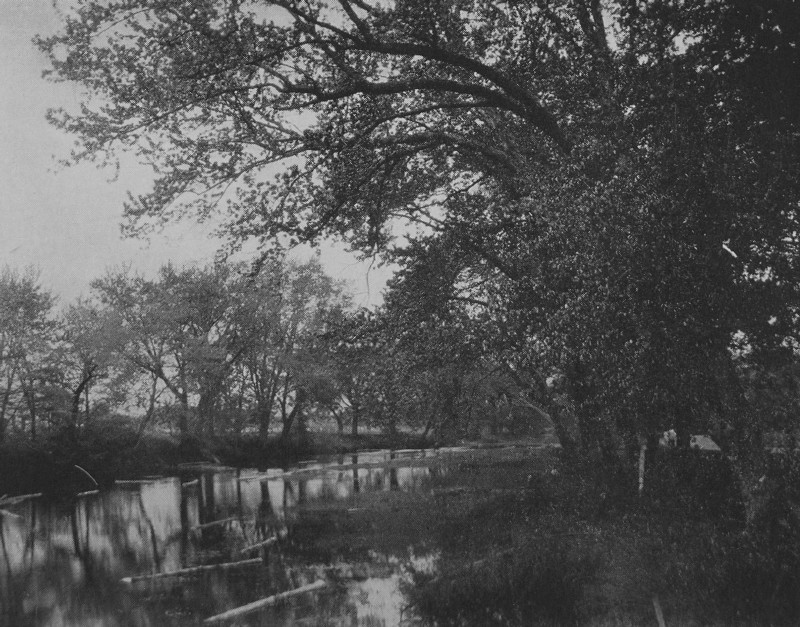 A LITTLE MAINE RIVER - FRYEBURG 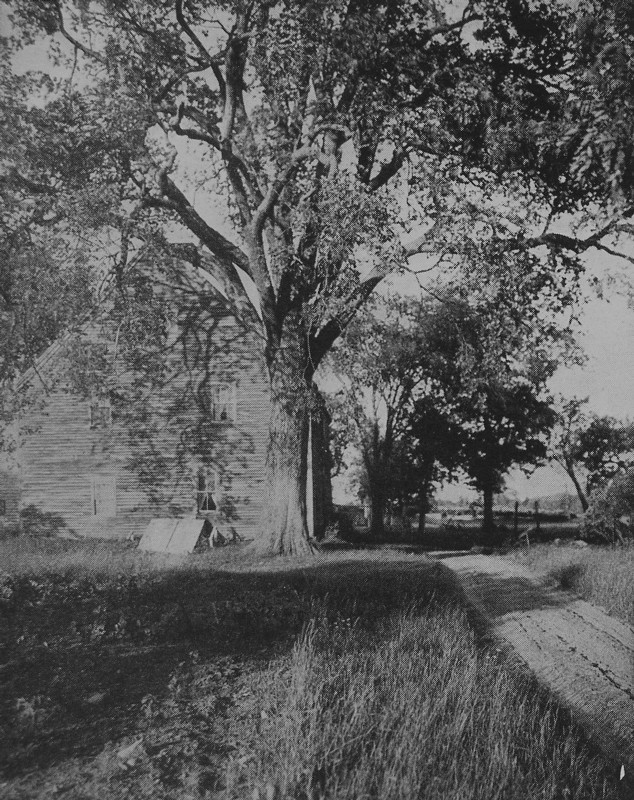 OLD DENNETT HOUSE - ELIOT 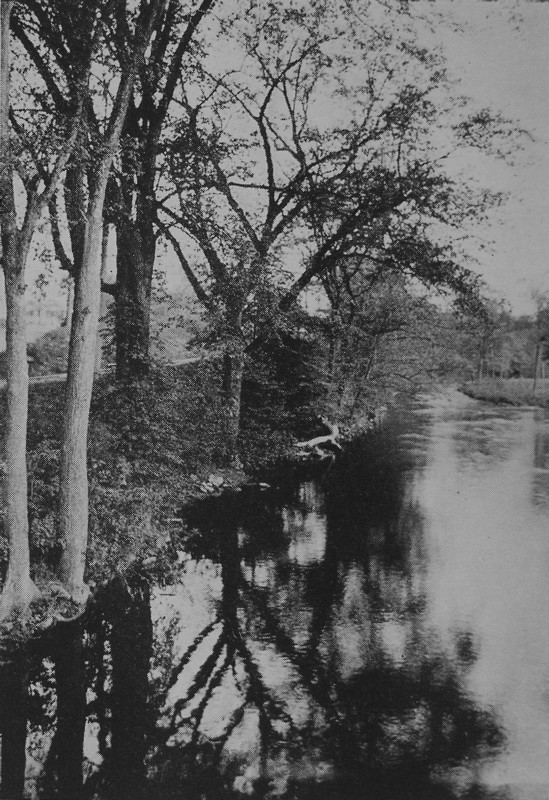 RIVERSIDE - PORTLAND PARK Yarmouth has an
old-world sound. Its rivers, coves, headlands, have afforded for many
years
pleasurable summers for tourists. Its Drinkwater Point is most aptly
named,
especially being in Maine. One is often
astonished, as at Freeport, to know that he is only a mile from salt
water when
on the main road. If we would see the Maine coast at its best, we must
ever
follow the rambling, dipping, curving, coast road, which invariably
charms us. At Brunswick
the
shadows of great elms protect Maine's old classic seat, Bowdoin
College, with
its fine campus. Here also the rushing Androscoggin makes its last
turmoil
before sinking into the splendid waters of Merrymeeting Bay. Brunswick
is the
sort of town one might seek as a residence, especially if he combined
scholarly
tastes with a love of the country. For here he would be close to
Harpswell,
Orr's Island, and the endless miles of coast line that border these
historic
and picturesque locations. Following up the Androscoggin he finds that
in its
lower reaches it has not altogether lost the charm which it had in its
youth at
Rumford and Dixfield. The distance to Bath is short, and one is also in
line to
proceed northerly from Brunswick to the fair banks of the Kennebec, and
the
region beyond. If we here
follow
the shore to Bath, we reach a truly maritime city, with fine past
traditions
brought down to the present day, of efficient construction in all sorts
of sea
craft, either for the merchant service or the navy. Here were born many
of the
clipper ships, and here, even in the last great war, the nation found
help for
its sea craft construction. A project for
the
erection of a great bridge at Bath is now being mooted. We do not
object to the
ferry, if we have leisure, but who has leisure? At Bath we pass to a
region in
Maine that has lacked and, as some say, has desired to lack the
commercial
activity found to the west of the Kennebec. The highly important estuaries of the Sheepscot and Damariscotta rivers appealed to the earliest explorers of the New England coast so much that they chose these locations in preference to all others. It was at Pemaquid that a pre-Pilgrim settlement of some importance was formed, and at Edgecomb, an ancient fort, whose block-house remains, was erected. There have been dreams of making Wiscasset the Maine outlet for Canada. The deep waters of these estuaries and their high banks seem to the enterprising American to call for a very large development. Meantime, the traveler who loves quiet finds an irresistible attraction in these Maine villages. Wiscasset enjoys a well-deserved reputation for the beauty and quaintness and dignity of its green, and the old dwellings about it. Perhaps there is no other Maine village able to compete with this in the range of its attractions. For the most part it is thought of as a lovely village, but as a center for boating and driving it has a broader and perhaps more important appeal. We found right about Wiscasset and up the Sheepscot and in Woolwich, Dresden, and Pittston, a very great number of compositions containing the elements so dear to the lover of rural life. Woolwich, indeed, fairly belongs to Bath, but as one goes north the western bank of the Kennebec is replete with orchards, quaint early dwellings, minor streams with their little falls, and maple-crested hills for many a mile, even to Winslow, opposite Waterville. Damariscotta has on an estate bordering its inland coves, a wonderful series of birch banks. Its lake, lying a little to the north, and favored by quickly-sloping banks, reminds us of Camden, with its bay and lake, except that here the elevations are not so great. THE BLOCK-HOUSE, NORTH EDGECOMB The tide of
traffic
on this portion of the Maine coast is found farther south on the
peninsulas of
Boothbay, and those on either hand from it. As we saw over a wealth of
cherry
blossoms, well on in June, the harbor of Boothbay, we thought the
setting was
near to perfection. At East Boothbay, also, there is no end of pleasure
in
exploring the little inlets, some of which have been availed of by tide
dams.
The entire region with its orchards, farm houses, and shores, allowing
one to
pass back and forth from the sea to the inland attractions, is most
satisfactory.
Wandering on through Waldoboro, and Warren to Rockland, we find again,
at the
last named, a commercial center. It is the first point touched by
steamers
approaching the wonderful bay of the Penobscot, with its surrounding
delights,
as at Camden, Castine, and the islands. We have
hitherto
adverted to Camden, and have hinted at its excellence. In its harbor,
its
mountains, and its lakes, it easily maintains a distinction such that
one
forgets comparisons. They are not necessary. The charm of Camden,
looking
seaward or landward from its mountains, and the joy of its back-country
drives,
like those to Union and Washington and Lincolnville, are enough to help
us to
forget the many things that fill life without blessing it. Returning to
Pemaquid, we find a region of mystery, and therefore of interest.
Excavations
have uncovered pavements, and pavements, at the beginning of the
seventeenth
century, mark a very enlightened or very medieval spirit. It would
appear that
the founders designed to lay out a town of pretensions. It was only by
the
barest chance that Pemaquid failed to be the Boston of New England. The
state
has restored the ancient stone block-house, and has thus provided a
nucleus for
the earliest romance of the east, if we except the mystery of the stone
tower
at Newport. Investigations at Pemaquid are not concluded. It is
possible that
more light may yet be thrown upon this primitive settlement. The location of
the
North Edgecomb block-house is fine. The old ramparts are in places
almost intact.
It is a sad commentary on our carelessness of these ancient monuments,
that
people should be allowed to roam at will about them, cutting their
insignificant names in the venerable timbers, and chipping away relics.
So fine
a monument as this deserves careful protection. While we are on
the
subject, we may as well call attention to the remaining block-house at
Winslow.
It is square, and therefore much simpler than that at Edgecomb, but is
more
respectably protected. These are the principal relics, in an
architectural
sense, in Maine, of the ancient time, and a pilgrimage to them,
including the
natural attractions that lie between, may fill one or two joyous days. The fine harbor formed in Penobscot Bay by the islands off its mouth is a fitting approach to the river, whose dimensions might almost be called lordly. Running up this stream past delightful old Castine and Bucksport, we reach the fine city of Bangor. In the solidity and attractiveness of its public buildings, and in its natural advantages as a center of the lumbering and agricultural interests of Maine, Bangor is important. It is also the base of extensive water trips northward. The roads center here from the Provinces, from Aroostook, and from the mountain and lake region, of which Millinocket is the second gateway. A WISCASSET MANSION One may
approach
Bar Harbor from Bucksport, crossing the river there by ferry, or may
make the
longer journey through Bangor. Ellsworth is the doorway of Mt. Desert.
It has a
fine attraction of its own in Union River, in both directions from the
town. Mt. Desert is
so
extensive that it includes many sorts of scenery, and in spite of the
strong
trend of fashion toward it, there yet remain many opportunities for
dwellings
that need lack nothing in the way of satisfactory outlooks. The center
of most
towns is the least interesting portion, and this statement is true of
Mt.
Desert. We have not learned, and probably we may never learn, to
combine beauty
with business. Not that the combination is impracticable, or even
difficult,
but it requires a harmonious effort, and long planning in advance.
Otherwise
the almost total obliteration of a town is necessary before it can be
reëstablished on harmonious lines. This, of course, is not to
be thought of. It
is only in the development of new centers that men of vision may
provide for
desirable architectural centers. Mt. Desert is
yet,
for the most part, free from that fenced-in condition and ever-present
sense of
hostility which marks Newport. The people of Mt. Desert have manifested
fine
feeling for the beauty of their island as a national focus of joy. This
is a
happy circumstance, which we hope will continue as the island develops.
A score
of years hence the number and the quality of the residences on the
island will
be such that the importance of the right spirit toward the general
public will
be increasingly felt. Passing from Ellsworth and Machias to Eastport, one sees little as yet of efforts to use the coast as an esthetic asset. The region has been lumbered. In process of time, of course, these interesting bays and promontories must come to their own, as the refuge and the solace of weary America. Extensive as the Maine coast is, the greatness of our country will find it not one mile too long. In this latter portion of the Maine coast journey, one passes occasionally estuaries of striking natural beauty. The rush of the tides, coming up to meet the little cascades that are formed at low water, is an unending source of pleasure. At the Sullivan ferry, which, by the way, may be avoided, the present outrageous toll ought not to be tolerated. It is finally to be done away by the completion of a great bridge. Millbridge, Cherryfield, and Jonesboro are the starting points of attractive inland roads, and from Machias one may journey north, omitting Eastport, and threading the lake region to Calais. Eastport, however, should be taken in by everyone, and the interior route may be followed as a side trip. There is room for romance as one sees the stone stairs at Eastport docks, reaching down, down, down, deep beneath the green water. The tremendous tide here offers room for a story by an American Hugo. PASSAMAQUODDY
BAY FOR more than
forty
years, since the author while a student enjoyed a wonderful summer on
Campobello Island, to the present hour, Passamaquoddy Bay has been a
glittering, beckoning memory. It is a fitting approach to our country
on the
east. Though marred now by the brutal criminality of rum running, its
dimpling
waters will at last, of course, be redeemed to peaceful beauty. For
many miles
the Maine shore, indented by hidden bays and the fascinating pagoda
shapes of
evergreens on the little peninsulas, extends to the St. Croix. At
present it is
only those who have the discernment to go far and to form their homes
by
humoring rather than thwarting nature, who enjoy the shores of the bay.
We have
not seen any computation of the possible power to be developed by the
great
tidal dam, which exists in dream only, from the region of Eastport to
Nova
Scotia. Doubtless, however, the power developed could be gigantic,
dwarfing any
similar impounding of fresh water. Thought of as a future achievement,
this
project will naturally place Eastport, and the towns to the north, at
the
center rather than at the edge of things. Happily such a development
will
interfere in no way with the charm of these waters. The New Brunswick
towns, as
seen from the Maine shore, have an almost English outline. St. Croix
Island
lies beautifully embosomed near the shore. MAINE'S
MOUNTAIN
REGIONS IT is perhaps
true
that the mountain region of Maine is more extensive than that of New
Hampshire.
This may seem a startling statement. The size of Maine, however,
permits a
mountain here and there more or less disconnected with any main range.
If all
the mountain sections were collected, as is true in New Hampshire with
the
exception of Monadnock, we should have a very impressive mass of
mountains. The
chief among them is Katahdin. At present the approach to this noble
eminence is
rather difficult. The best route in is perhaps from Millinocket. It
necessitates leaving the motor car and taking a truck, then to a canoe,
and
finally another truck, and a tramp. Another approach is by way of
Greenville
and the Ripogenus Dam. A walk of some six miles is ended by a canoe
trip
followed by a shorter walk. Then it is the canoe again. However, if one
wishes
a fine view of the mountain he may gain that from the Sourdnahunk. This
is the
picture which we show. We arrived on a day of beautiful summer clouds. As one stands on the dam the waters rush out through the gates in broad torrents of creamy foam. Above stands the mountain with its table top, and above that float in the quiet azure the splendid billows of cloud. The contrast between the turbulence below and the serenity above gives a still greater attraction to the river and the mountain. This stream is the west branch of the Penobscot. The mass of Katahdin and its separation from other mountains give it a fine dignity. It is perhaps on this account the most impressive peak east of the Rockies. Its absolute height is almost exactly a mile. We have not yet seen government maps of this part of Maine, but we hope that they may be completed soon. This mountain is one of a series as we pass westward, skirting several peaks until one reaches the Spencer Mountains east of Moosehead. Their elevation exceeds three thousand feet. They are closely allied with Kineo, which, owing to its strategic location, is probably the best-known mountain in Maine except Green Mountain on Mount Desert. The sail up Moosehead Lake from Greenville reached by motor or by rail, is far and away the most impressive experience one can gain from scenery in the interior of New England. The lake is bordered with fine mountains for a greater part of its extent. 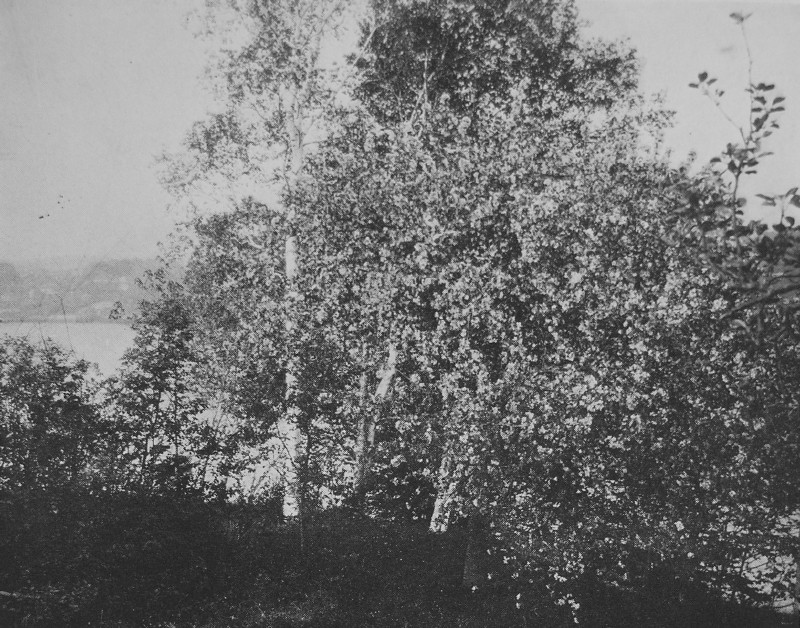 A ROCKPORT NOOK 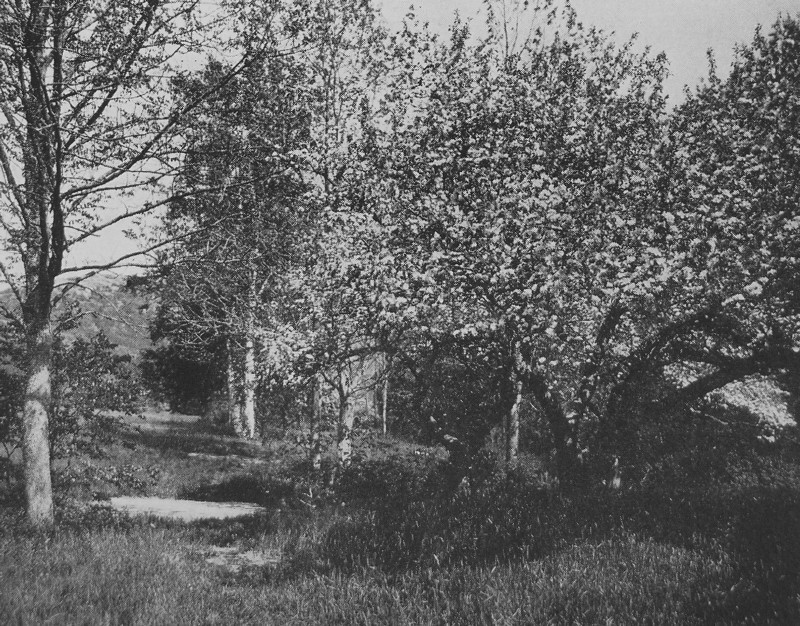 APPLE AND ASH - CAMDEN 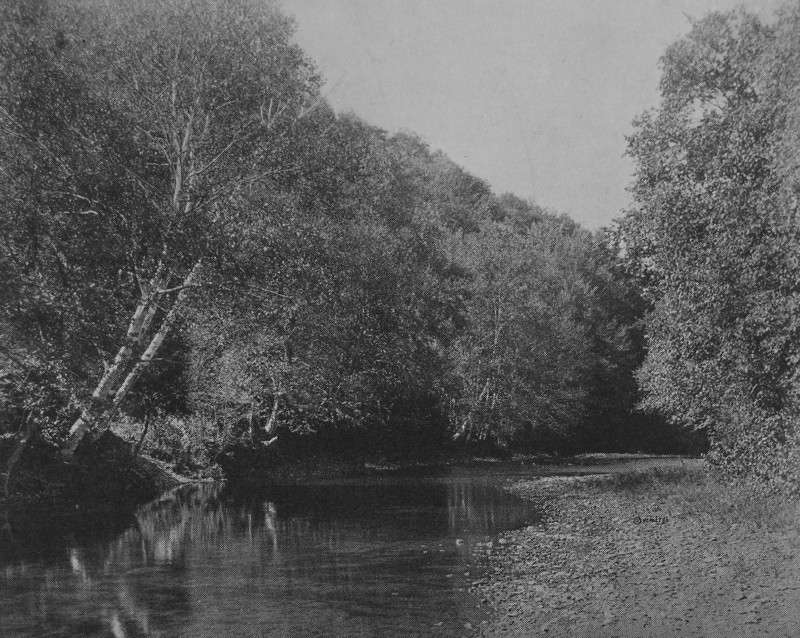 A LITTLE OXFORD RIVER  WINTER SPORTS 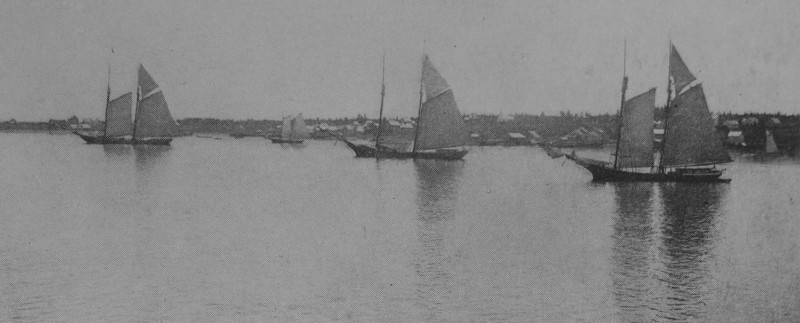 THREE SISTERS - BAR HARBOR 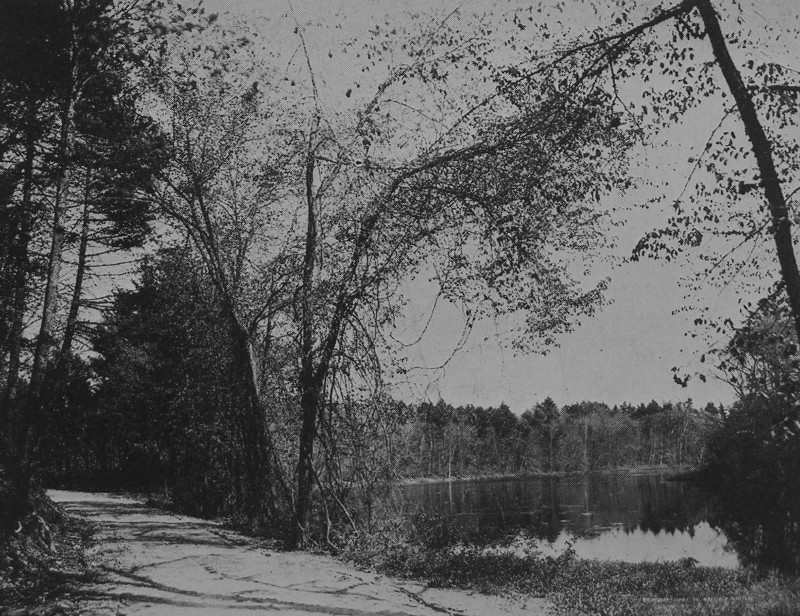 A CAMDEN DRIVE 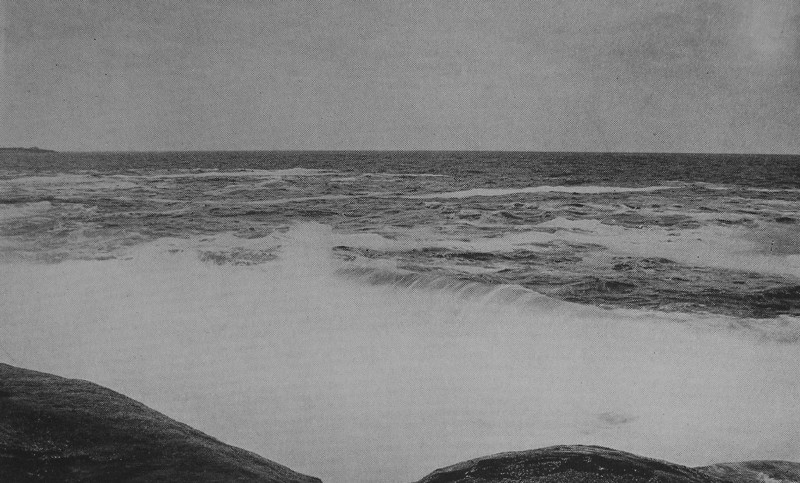 ATLANTIC ROLLERS - YORK 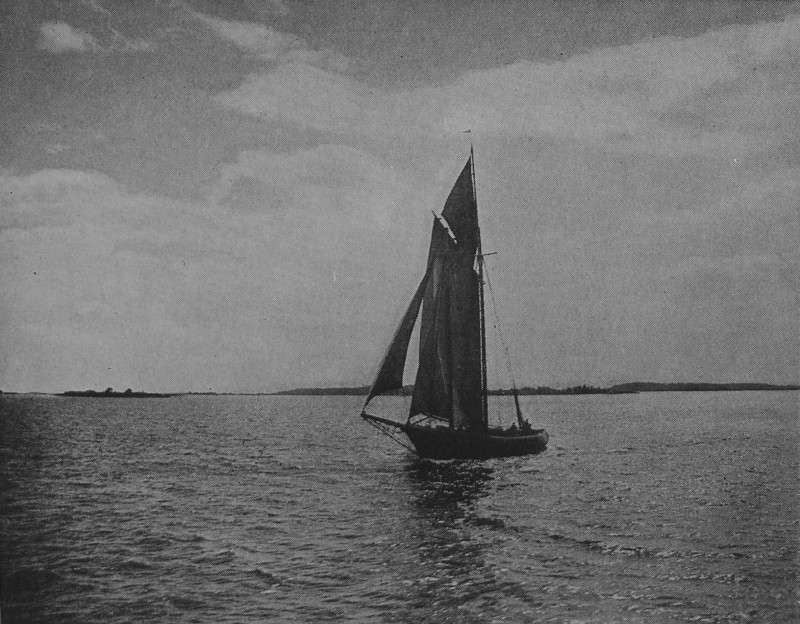 A QUIET SAIL We enjoyed a
phenomenon wholly new to us. As we passed by the Spencer range we had a
drenching thunder shower. It fell between us and the range. On either
side of
the shower we observed the sun shining. It was a demonstration in
physical
geography such as we had seen in sketches but never before in reality.
The
mountains were partly swathed in mist, affording vague and dreamy
outlines, and
appeared to be the parents of the storm. The remarkable feature was the
absence
of storm fore and aft of our steamer. As we approached Mount Kineo we
found it
well below great masses of white cloud, but with the splendid blue
predominating. It is an object of grandeur and delight. The sheerer
descent is
seen from the opposite side. There are about Moosehead other peaks of
much
beauty, as Squaw Mountain near Greenville. The great extent of lake
affording
an almost straightaway sail of forty miles, with its innumerable bays
and
headlands, and its almost perpetual glory of cloud and color, are all a
wonderful experience to those who see them for the first time. |